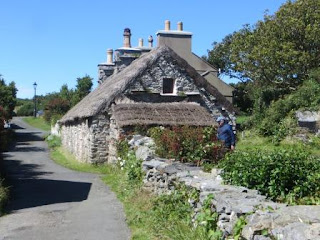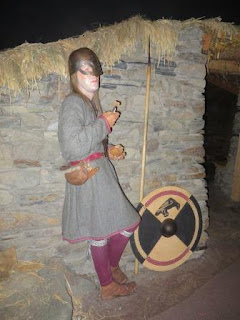This is the last BLOG post I'll make on the Isle of Man because I'm running well behind time. Since departing the island I've been to Plymouth and then to the Peak District in northern England for about four days. After that, I spent four nights in Oxford to attend the 4th World Conference on Economic Geography (the first three meetings were in Singapore, Beijing and Seoul and I attended the last of those). Then, after visiting a National Trust Home called Claydon House in Buckinghamshire, I dashed to Heathrow for the last leg of my journey, Believe it or not, I flew in the early evening to Bucharest where a friend is kindly paying my way and, in return, address research students, an official in Romania's regional development ministry, and several rural mayors!! What a hectic life.
OK on with the story. The IoM is a treasure trove of historic properties and we'll visit several in turn actually three in all, Laxey, Cregneash and Rushen Abbey. Laxey is one of the gems of British industrial archaeology. In essence, a water-driven wheel (Lady Isabella) drove pumping mechanisms to keep mines producing lead, copper, silver and zinc in operation until the mines closed finally in 1929. It is the largest such wheel in the world.
To get to it, we walked along a street lined with miners' cottages and this memorial to miners.
The day we were there, the wheel was rotating - driven by water - but was nnot driving the pumping mechanism.
The rotating wheel drove a very long rod back and forwards and this, in turn, was converted to a vertical pumping action at its very end.
Water was collected in holding tanks like this from a series of local streams and, the tanks were higher in altitude than the top of the Laxey wheel. So water was then gravity fed to the top of the wheel to keep it rotating.
The site is covered in the ruins of mining operations like those shown here.
And so to Port Erin in the island's far west. It's an attractive beach-side town.
But the reason for visiting the area was to see Cregneash, a beautiful working heritage village, now controlled by the Manx version of the National Trust. The buildings themselves have been restored and are now home to tableaux portraying village life. One can see homely scenes and workshops, along with samples of livestock produced, mainly chickens and sheep.
Cregneash is remote, pretty wild, and close to the Calf of Man already reported on these pages. Notice also the weather, which behaved for once and gave us warm sunshine. And so to Rushen Abbey, Founded in 1134 by Viking King Olaf 1, this shortly after became a Cistercian Monastery, but was dissolved by Henry VIII in the 16th century. Little now remains apart from the odd tower, a few broken walls and some pleasant gardens. But we did get a feel for the life of the monks, which struck me as pretty dreary given endless and repetitive rituals. You may think differenetly.
AS
OK on with the story. The IoM is a treasure trove of historic properties and we'll visit several in turn actually three in all, Laxey, Cregneash and Rushen Abbey. Laxey is one of the gems of British industrial archaeology. In essence, a water-driven wheel (Lady Isabella) drove pumping mechanisms to keep mines producing lead, copper, silver and zinc in operation until the mines closed finally in 1929. It is the largest such wheel in the world.
The day we were there, the wheel was rotating - driven by water - but was nnot driving the pumping mechanism.
The rotating wheel drove a very long rod back and forwards and this, in turn, was converted to a vertical pumping action at its very end.
Water was collected in holding tanks like this from a series of local streams and, the tanks were higher in altitude than the top of the Laxey wheel. So water was then gravity fed to the top of the wheel to keep it rotating.
The site is covered in the ruins of mining operations like those shown here.
But the reason for visiting the area was to see Cregneash, a beautiful working heritage village, now controlled by the Manx version of the National Trust. The buildings themselves have been restored and are now home to tableaux portraying village life. One can see homely scenes and workshops, along with samples of livestock produced, mainly chickens and sheep.
Cregneash is remote, pretty wild, and close to the Calf of Man already reported on these pages. Notice also the weather, which behaved for once and gave us warm sunshine. And so to Rushen Abbey, Founded in 1134 by Viking King Olaf 1, this shortly after became a Cistercian Monastery, but was dissolved by Henry VIII in the 16th century. Little now remains apart from the odd tower, a few broken walls and some pleasant gardens. But we did get a feel for the life of the monks, which struck me as pretty dreary given endless and repetitive rituals. You may think differenetly.
AS




























































